
 |

|
| ActiveWin: Reviews | Active Network | New Reviews | Old Reviews | Interviews |Mailing List | Forums |
|
|
|
|
|
DirectX |
|
ActiveMac |
|
Downloads |
|
Forums |
|
Interviews |
|
News |
|
MS Games & Hardware |
|
Reviews |
|
Support Center |
|
Windows 2000 |
|
Windows Me |
|
Windows Server 2003 |
|
Windows Vista |
|
Windows XP |
|
|
|
|
|
|
|
News Centers |
|
Windows/Microsoft |
|
DVD |
|
Apple/Mac |
|
Xbox |
|
News Search |
|
|
|
|
|
|
|
ActiveXBox |
|
Xbox News |
|
Box Shots |
|
Inside The Xbox |
|
Released Titles |
|
Announced Titles |
|
Screenshots/Videos |
|
History Of The Xbox |
|
Links |
|
Forum |
|
FAQ |
|
|
|
|
|
|
|
Windows XP |
|
Introduction |
|
System Requirements |
|
Home Features |
|
Pro Features |
|
Upgrade Checklists |
|
History |
|
FAQ |
|
Links |
|
TopTechTips |
|
|
|
|
|
|
|
FAQ's |
|
Windows Vista |
|
Windows 98/98 SE |
|
Windows 2000 |
|
Windows Me |
|
Windows Server 2002 |
|
Windows "Whistler" XP |
|
Windows CE |
|
Internet Explorer 6 |
|
Internet Explorer 5 |
|
Xbox |
|
Xbox 360 |
|
DirectX |
|
DVD's |
|
|
|
|
|
|
|
TopTechTips |
|
Registry Tips |
|
Windows 95/98 |
|
Windows 2000 |
|
Internet Explorer 5 |
|
Program Tips |
|
Easter Eggs |
|
Hardware |
|
DVD |
|
|
|
|
|
|
|
ActiveDVD |
|
DVD News |
|
DVD Forum |
|
Glossary |
|
Tips |
|
Articles |
|
Reviews |
|
News Archive |
|
Links |
|
Drivers |
|
|
|
|
|
|
|
Latest Reviews |
|
Xbox/Games |
|
Fallout 3 |
|
|
|
Applications |
|
Windows Server 2008 R2 |
|
Windows 7 |
|
|
|
Hardware |
|
iPod Touch 32GB |
|
|
|
|
|
|
|
Latest Interviews |
|
Steve Ballmer |
|
Jim Allchin |
|
|
|
|
|
|
|
Site News/Info |
|
About This Site |
|
Affiliates |
|
Contact Us |
|
Default Home Page |
|
Link To Us |
|
Links |
|
News Archive |
|
Site Search |
|
Awards |
|
|
|
|
|
|
|
Credits |

|
Product: Intel D815EPEA2 & Celeron
850/100MHz Review |
Benchmarks
|
Table Of Contents |
Since a review cannot be complete without the usual benchmarks, here we go. To test the Celeron 850MHz we obviously used the Intel D815EPEA2 motherboard. The configuration of the system was:
- Intel D815EPEA2 Motherboard (with P03 Bios),
- 256Mb SDRAM PC133,
- Seagate 20GB UDMA 66 Hard Disk,
- GoldStar DVD-Rom 8120b,
- Hercules 3D Prophet 4500 64Mb (with drivers 7.56),
- Pinnacle Studio DV,
- Microsoft Natural Keyboard Pro,
- Microsoft IntelliMouse.
Everything was running on a fresh and clean install of Microsoft Windows 2000 Professional with Service Pack 1. We used several benchmarking tools to test the performance of the Celeron 850MHz CPU with its dedicated i815EP chipset that were: CPU Mark, SiSoft Sandra 2001, ZD Content Creation 2001, ZD Business Winstone 2001, Quake III Arena.
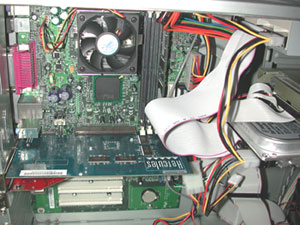
Inside our test system
(click to enlarge)
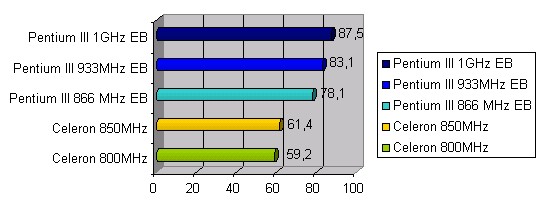 |
The CPU Mark benchmark tool reveals the power of the processor. As you can see even at equal frequency the Celeron is behind the Pentium 3 in terms of performance which is normal due to its restricted architecture. You’ll notice that the Celeron 850MHz surpasses the Celeron 800MHz with a very weak advance.
|
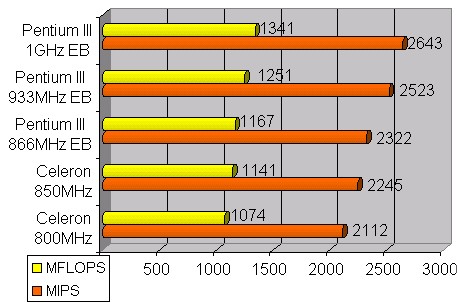 |
Using SiSoft Sandra 2001, we benchmarked
various
processors from Celeron to Pentium III using the same Intel D815EEA2
motherboard. As you can see
the
MIPS (
|
MFLOPS: The Whetstone benchmark is widely used in the computer industry as a measure of performance. Floating-point arithmetic is most significant in scientific, engineering, statistical and computer-aided design (CAD) programs. It is also a small component in spreadsheet, paint and drawing programs. Word processing programs typically do no floating-point computations at all. The Whetstone does a lot of floating-point arithmetic, some memory access, and a little integer arithmetic.
MIPS: The Dhrystone benchmark is widely used in the computer industry as a measure of performance. Dhrystone is a synthetic benchmark, designed to contain a representative sample of operations normally performed by applications. They don't calculate a result of any kind, but they do perform the sort of complicated sequences of instructions that real applications use. The Dhrystone result is determined by measuring the time it takes to perform these sequences of instructions. Simple integer arithmetic, logic decisions, and memory accesses are the dominant CPU activities in most Windows programs. The Dhrystone benchmark makes intensive use of these areas.
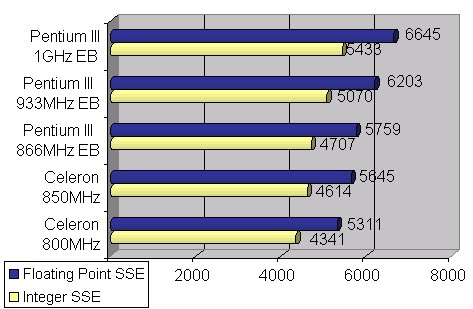 |
Using SiSoft Sandra 2001 Pro, we ran the CPU Multimedia benchmark to compare the performances of our various processors on the D815EEA2 Motherboard. In this configuration the Celeron 850MHz shows a real power gain over the Celeron 800MHz. |
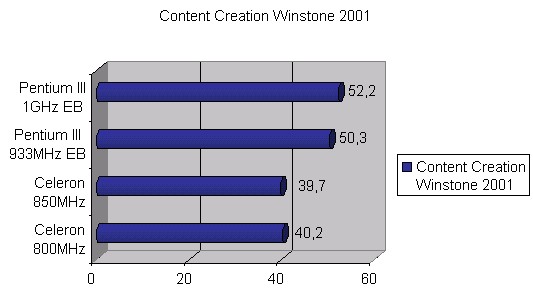 |
Here are the results the Ziff Davis Content Creation Winstone 2001 benchmark gives. Content Creation Winstone is a system-level, application-based benchmark that measures a PC's overall performance when running top, Windows-based, 32-bit, content creation applications. As you can see and even if I reran the tests several times the Celeron 850MHz gives poorer performance than the 800MHz supposed to be the slowest. |
 |
Business Winstone is a system-level, application-based benchmark that measures a PC's overall performance when running today's top-selling Windows-based 32-bit applications. In this test the Celeron 850MHz shows a small advance over the 800MHz one. |
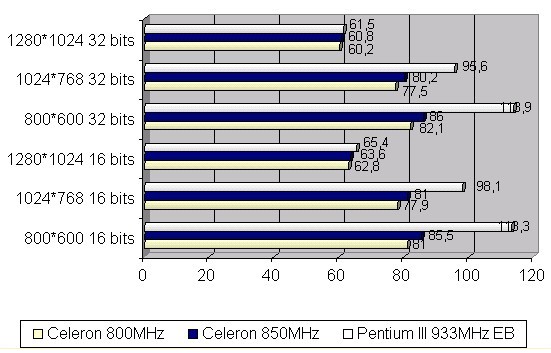 |
Here is the usual Quake III benchmark that shows fps aren't 100% dependent on the graphic card but also on the CPU. The Celeron 850MHz really enhances the performance of Quake III as you can see. |
To conclude, the Intel Celeron 850MHz shows some welcome additional power over the Celeron 800MHz but doesn't always surpass it: so if you own a Celeron 800MHz there's no reason to rush on the 850MHz model. Also at a somewhat equal frequency the Celeron 850MHz is relatively much slower than the Pentium III 866MHz which is due to the limited cache memory and other internal architecture design specifications like the FSB & SDRAM speed. You'll notice that in Quake III the Celeron 850MHz really offers a precious FPS gain that’ll spoil those hungry hardcore gamers. Strangely enough with the Ziff Davis Content Creation benchmark that uses huge application like Premiere, SoundForge, PhotoShop, the Celeron 850MHz arrives behind the 800MHz: after several tests the result was always the same. Anyway the Celeron 850MHz is definitely a very good platform to build office computers, first PC, kids PC or even family PC: it offers enough power for day to day use as well as gaming and is budget friendly :)
